Maintaining a clean and organized office is essential for ensuring a healthy, productive, and professional work environment.
While regular cleaning keeps things tidy on the surface, deep cleaning tackles hidden dirt, allergens, and bacteria that accumulate over time.
This comprehensive guide provides a step-by-step office deep cleaning checklist to help you achieve a spotless workspace.
Why Office Deep Cleaning is Essential
Deep cleaning goes beyond the basics of tidying up and disinfecting surfaces. It ensures that your office is not only visually appealing but also safe and hygienic for employees and visitors. Here are some key reasons why deep cleaning is vital:
- Promotes Employee Health: Accumulated dust, bacteria, allergens, and pests such as rats and cockroaches in the workplace can trigger respiratory problems, allergies, and even illnesses. Deep cleaning eliminates these risks.
- Enhances Productivity: A clutter-free, clean environment can improve focus and boost employee morale, leading to higher productivity.
- Leaves a Positive Impression: A pristine office reflects professionalism and leaves a great impression on clients, business partners, and potential employees.
- Extends the Life of Assets: Regular cleaning of office furniture, electronics, and fixtures can prevent wear and tear, saving money on replacements.
How Often Should Offices Be Deep Cleaned?
The frequency of deep cleaning depends on factors such as office size, foot traffic, and the nature of the work environment. Here’s a general guideline:
- Small to Medium Offices: Every 3–6 months.
- Large Offices with High Foot Traffic: Every 1–3 months.
- Post-Renovation or Seasonal Cleaning: As needed.
For offices with specific hygiene requirements, such as healthcare or food service, more frequent deep cleaning may be necessary.
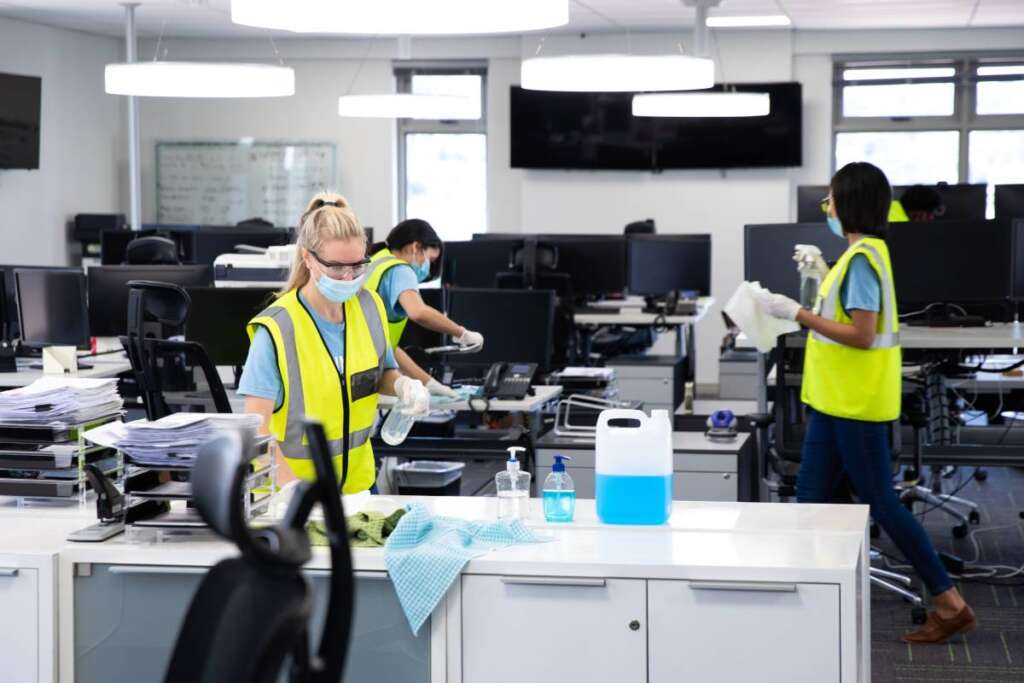
Preparing for an Office Deep Clean
Before starting, ensure you’re prepared for an efficient cleaning process:
- Declutter: Ask employees to remove personal items and organize their desks.
- Create a Plan: Divide cleaning tasks by area and assign responsibilities if you’re managing an in-house cleaning team.
- Gather Supplies: Stock up on cleaning products, microfiber cloths, disinfectants, mops, vacuum cleaners, and specialized equipment like carpet shampooers.
Office Deep Cleaning Checklist
A well-organized checklist ensures no area is missed. Here’s a comprehensive breakdown:
1. Reception and Lobby Areas
The reception area is the first thing visitors see, making it crucial to maintain.
- Wipe and Disinfect Surfaces: Clean reception desks, chairs, tables, and counters.
- Polish Glass Surfaces: Remove smudges and fingerprints from doors, windows, and mirrors.
- Vacuum and Mop Floors: Pay attention to carpets, rugs, and tiles.
- Dust Fixtures: Clean light fixtures, picture frames, and plants.
- Organize Materials: Arrange magazines, brochures, and flyers neatly and discard outdated ones.
2. Workstations and Desks
Workstations are high-touch areas prone to accumulating dirt and germs.
- Declutter and Organize: Clear desks of unnecessary items and papers.
- Sanitize Desks and Chairs: Disinfect surfaces, armrests, and chair backs.
- Clean Electronics: Use appropriate cleaning methods for monitors, keyboards, and mice.
- Vacuum Under Desks: Don’t forget hidden areas where dust accumulates.
- Disinfect Shared Equipment: Clean printers, copiers, and shared telephones.
3. Meeting Rooms
Meeting rooms are often shared by multiple people, making them a hotspot for germs.
- Clean Tables and Chairs: Disinfect all furniture thoroughly.
- Sanitize AV Equipment: Wipe down projectors, microphones, remote controls, and screens.
- Polish Glass Surfaces: Clean glass partitions and whiteboards.
- Vacuum Carpets: Focus on stains and high-traffic areas.
- Empty Trash Bins: Replace liners and disinfect the bins.
4. Kitchens and Breakrooms
Breakrooms are prone to spills, crumbs, and bacteria buildup.
- Clean Appliances: Wipe down microwaves, refrigerators, coffee machines, and toasters.
- Disinfect Surfaces: Sanitize countertops, tables, and cabinet handles.
- Wash Dishes: Ensure all utensils are clean and stored properly.
- Empty Trash: Remove trash, disinfect bins, and replace liners.
- Mop Floors: Address spills and stubborn stains.
- Check Expired Items: Clear out the refrigerator and pantry of expired food.
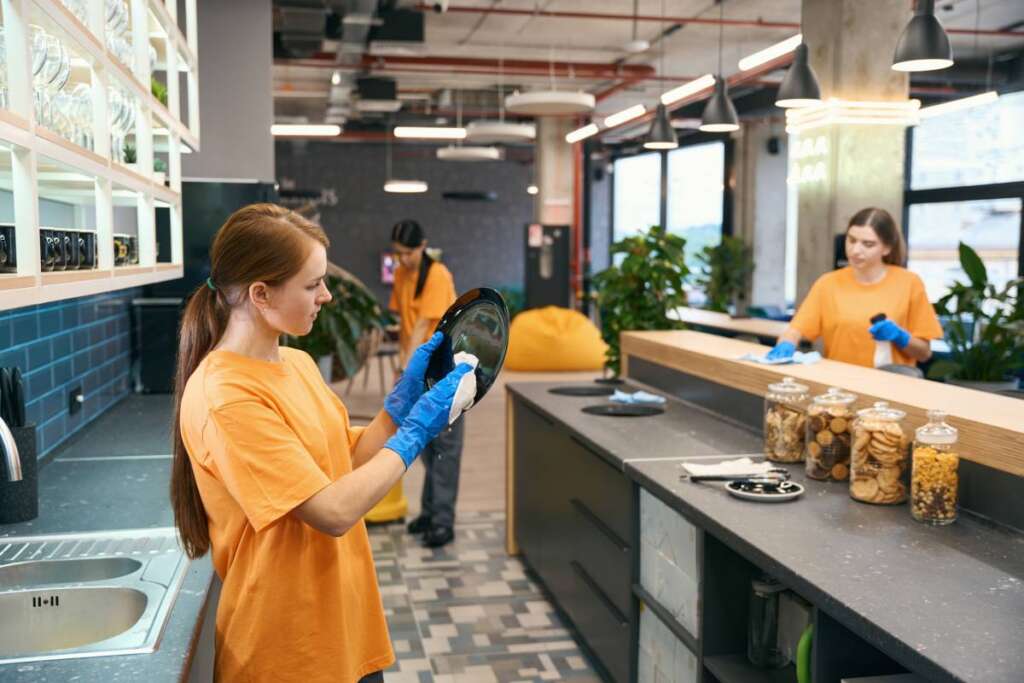
5. Restrooms
Restrooms require special attention to maintain hygiene.
- Scrub Toilets and Sinks: Use strong disinfectants for thorough cleaning.
- Polish Mirrors and Fixtures: Ensure faucets, mirrors, and soap dispensers are spotless.
- Restock Supplies: Refill soap, toilet paper, and hand sanitiser.
- Mop Floors: Use antibacterial cleaning solutions.
- Empty Sanitary Bins: Replace liners and deodorize the bins.
6. Floors and Carpets
Floors see the most wear and tear and need extra care.
- Vacuum Thoroughly: Focus on edges, corners, and under furniture.
- Shampoo Carpets: Use a carpet cleaning machine or hire professionals for deep stains.
- Polish Hard Floors: Use appropriate polish to restore shine and protect surfaces.
- Disinfect Tile Floors: Use a mop with an antibacterial cleaner to sanitize.
7. Windows, Blinds, and Curtains
Windows and window treatments often collect dust and grime.
- Wash Windows: Clean interior and exterior glass using a streak-free solution.
- Dust Blinds: Use a microfiber cloth or specialized duster to clean blinds.
- Clean Curtains: Vacuum or wash curtains as needed.
8. Storage Areas
Storage rooms can quickly become cluttered and dusty.
- Organize Items: Dispose of unnecessary items and clearly label boxes.
- Dust Shelves: Remove cobwebs and dust from shelves.
- Sweep and Mop: Clean the floor to remove accumulated dirt.
Additional Tips for Effective Deep Cleaning
- Use Eco-Friendly Products: Opt for non-toxic, biodegradable cleaning supplies to protect the environment and health.
- Plan for Non-Work Hours: Schedule deep cleaning during weekends or after office hours to minimize disruption.
- Hire Professionals: Consider professional cleaning services for specialized tasks like carpet shampooing or window washing.
- Implement a Maintenance Routine: Encourage employees to keep their workspaces tidy and maintain cleanliness between deep cleans.
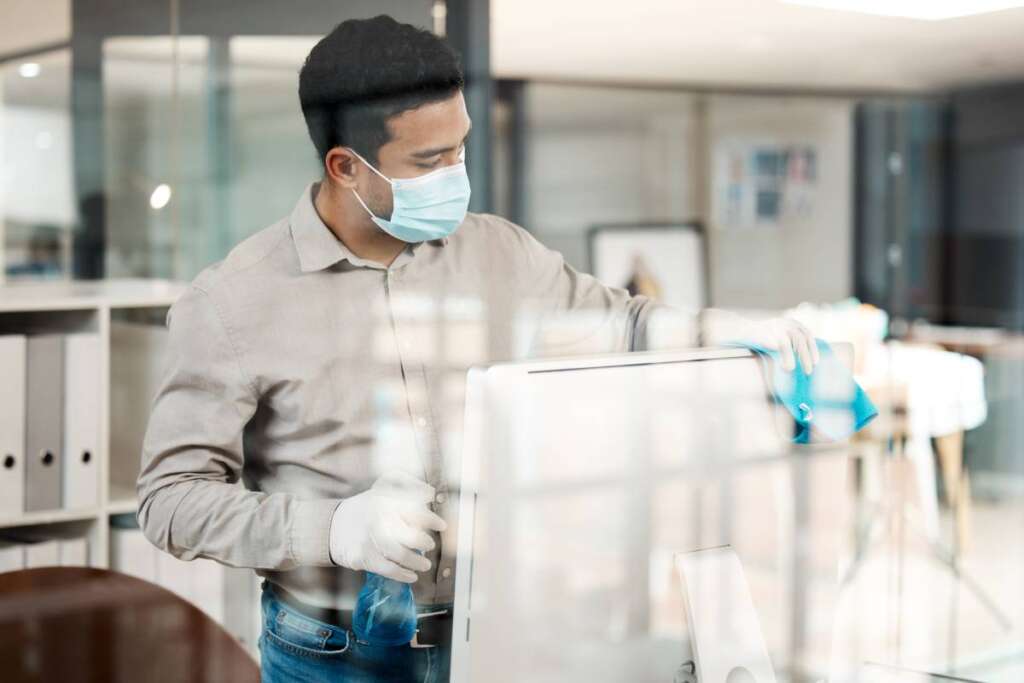
Common Mistakes to Avoid
- Skipping Hard-to-Reach Areas: Overlooked spots like vents, baseboards, and behind furniture can harbour hidden dirt and allergens.
- Using the Wrong Products: Match cleaning products to surfaces to prevent damage or inefficiency.
- Neglecting Electronics: Improper cleaning methods can damage costly equipment.
The Role of Professional Cleaning Services
While an in-house team may be capable of managing routine cleaning tasks, it is often beneficial to hire professionals for a deep cleaning. This approach not only saves valuable time but also ensures a more thorough and effective outcome.
Enjoy Life Services, a reputable professional cleaning company based in Sydney, provides a range of specialized services to enhance your cleaning experience. Their offerings include:
Advanced Equipment
They utilize high-quality tools and technology for carpet cleaning and window washing, ensuring a deeper clean and a streak-free finish.
Specialized Techniques
Enjoy Life Services employs effective methods specifically designed for disinfecting high-touch surfaces, which is essential for maintaining a safe and healthy environment, especially in offices and public spaces.
Expert Handling
Their trained professionals have the expertise needed to manage delicate office equipment and materials, ensuring that everything is treated with care while still achieving optimal cleanliness.
By choosing a professional service like Enjoy Life Services, you can focus on your core responsibilities while entrusting the cleaning to experts.
Maintaining a Clean Office Between Deep Cleans
- Encourage Daily Desk Cleaning: Provide disinfectant wipes for employees to clean their workstations.
- Empty Trash Regularly: Prevent overflowing bins and odours by scheduling daily waste removal.
- Set Up Hygiene Stations: Place hand sanitisers and tissue boxes in common areas.
- Inspect High-Traffic Areas: Regularly check lobbies, breakrooms, and restrooms for messes.
Conclusion
Deep cleaning is an investment in your office’s health, aesthetics, and functionality. By following this comprehensive checklist and planning regular cleaning schedules, you can create a workspace that boosts employee morale and leaves a lasting impression on visitors.
Whether you manage cleaning internally or hire professionals, consistency is key to maintaining a spotless and inviting office environment.
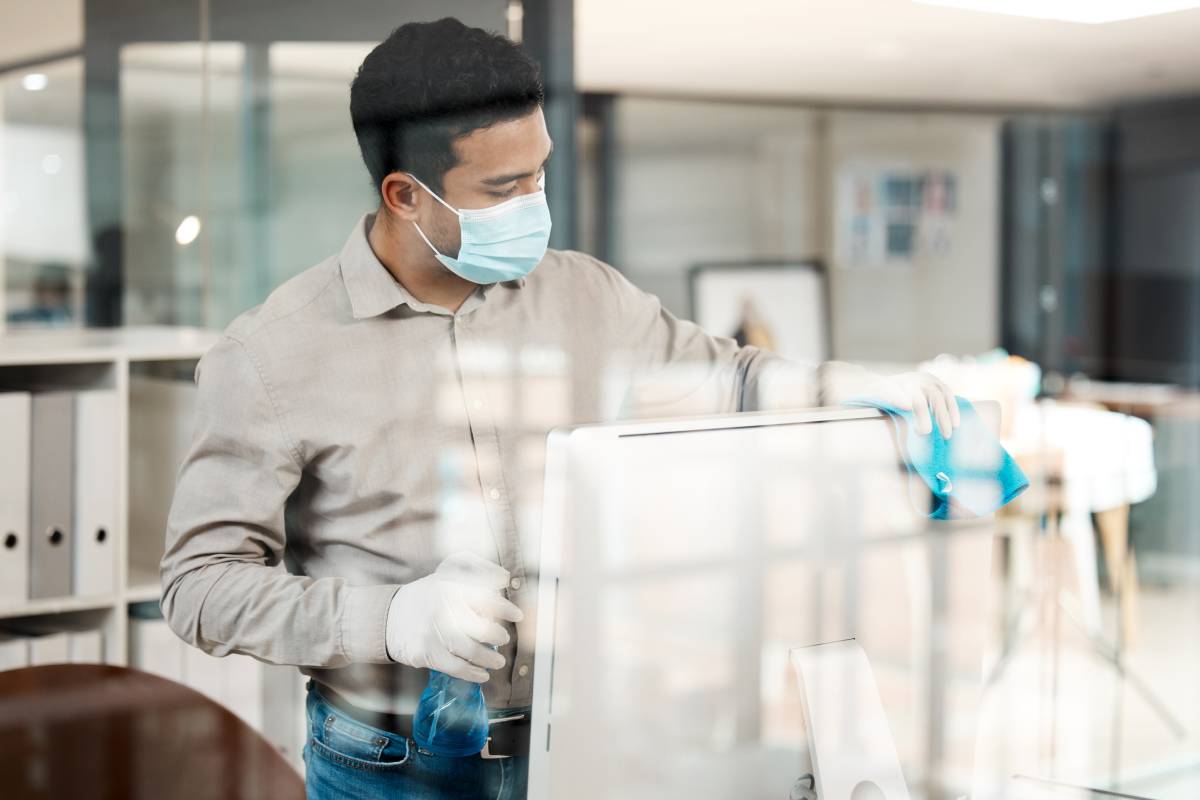

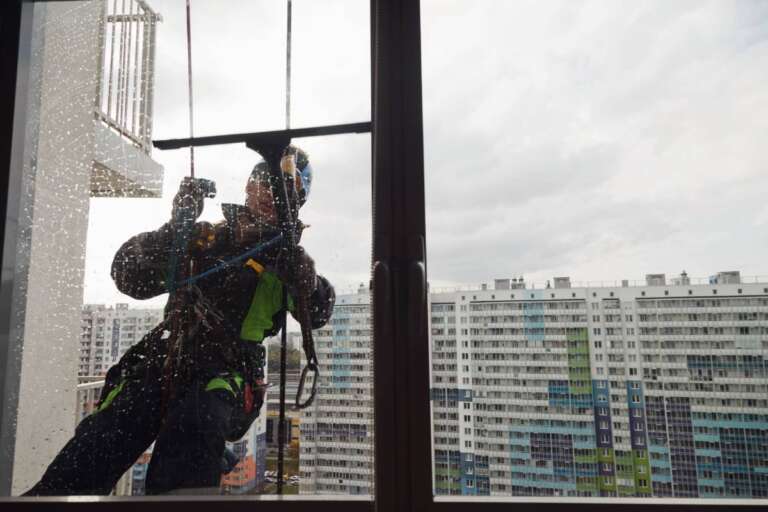
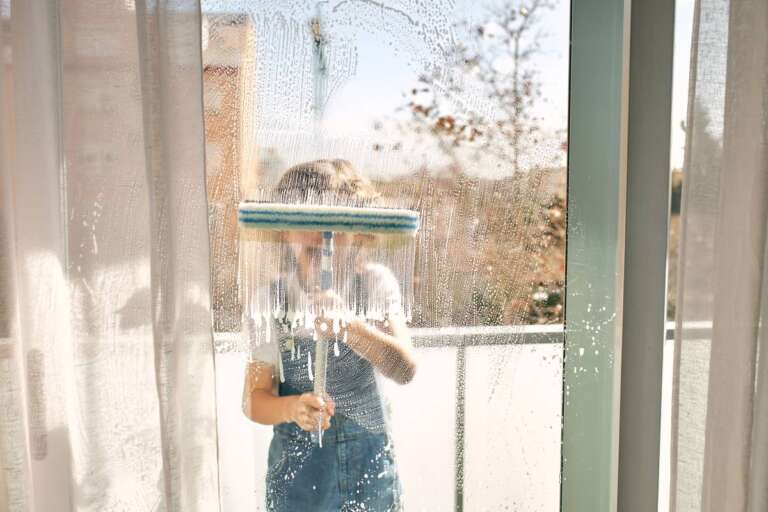




Leave a Comment